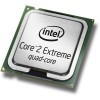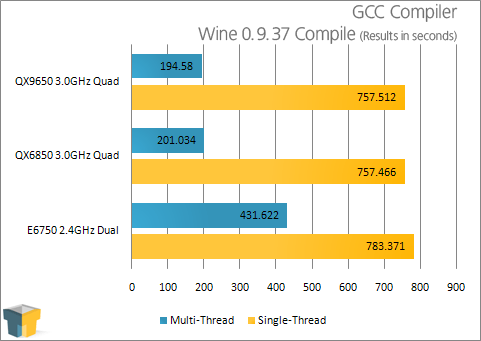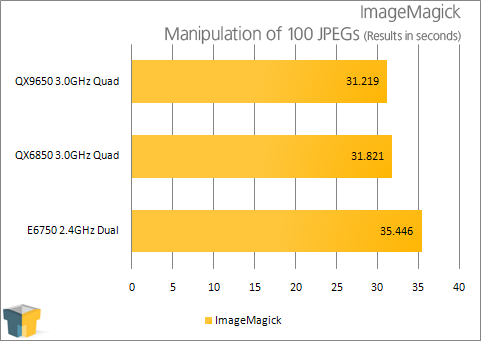- Qualcomm Launches Snapdragon 4 Gen 2 Mobile Platform
- AMD Launches Ryzen PRO 7000 Series Mobile & Desktop Platform
- Intel Launches Sleek Single-Slot Arc Pro A60 Workstation Graphics Card
- NVIDIA Announces Latest Ada Lovelace Additions: GeForce RTX 4060 Ti & RTX 4060
- Maxon Redshift With AMD Radeon GPU Rendering Support Now Available
Intel Core 2 Extreme QX9650 – The 45nm Era Begins

Intel will be launching their first 45nm desktop processor in a few weeks, but we have an in-depth look for you here today. Penryn brings improved efficiency, new high-k metal gate transistors, additional cache and something that will make multimedia buffs rejoice: SSE4. Welcome to the 45nm era!
Page 9 – Linux: GCC Compiler, ImageMagick
GCC Compiler
When thinking about faster processors or processors with more cores, multi-media projects immediately come to mind as being the prime targets for having the greatest benefit. However, anyone who regularly uses Linux knows that a faster processor can greatly improve application compiling with GCC. Programmers themselves would see the greatest benefit here, but end-users who find themselves compiling large applications often would also reap the rewards.
Even if you don’t use Linux, the results found here can benefit all programmers, as long as you are using a multi-threaded compiler. GCC is completely multi-core friendly, so the results found here should represent the average increase you would see with similar scenarios.
For testing, we used SabayonLinux Professional 1.1 x86. We normally use Fedora, but no version that we tried would function properly, and due to a tight deadline, we chose SL instead. Our problems with Fedora are not due to the processor, but rather either the motherboard chipset or our 8800GTX card.
Our target is a copy of Wine 0.9.47. The distro is based on the 2.6.23 Linux kernel and we are using GCC 4.1.2 as our compiler. For single core testing, “time make” was used while dual and quad core compilations used “time make -j 3” and “time make -j 5”, respectively.

We didn’t expect much of an increase here, and in single-thread mode, there wasn’t. Using all four cores though, however, we saw a 3.6% increase over the dual-core E6750.
ImageMagick
Even though multi-core processors are not new, it’s tricky finding a photo application that handles them properly. Lightroom was one, Photoshop is another. In light of the fact that it’s difficult to write scripts for more popular image manipulation applications, we are going to test the single core benefit of ImageMagick, a popular command line image application for Linux, Windows and Mac OS. It’s most commonly used on web servers, but can be used locally as well.
The benchmark consists of taking the 100 output JPGs from our Adobe Lightroom tests and watermarking them. Then, our script creates 500×335 thumbnails for each of those. This benchmark accurately represents the exact same process that our own review images go through.

We even saw a minor increase with our ImageMagick run, but minor is the key word here. Next up, we will be taking the QX9650 through nine different games, to see if 45nm benefits can be seen there.
Support our efforts! With ad revenue at an all-time low for written websites, we're relying more than ever on reader support to help us continue putting so much effort into this type of content. You can support us by becoming a Patron, or by using our Amazon shopping affiliate links listed through our articles. Thanks for your support!





